VOLVO C70 CONVERTIBLE 2007 Owner´s Manual
Manufacturer: VOLVO, Model Year: 2007, Model line: C70 CONVERTIBLE, Model: VOLVO C70 CONVERTIBLE 2007Pages: 276, PDF Size: 9.81 MB
Page 141 of 276

2007 Volvo C70
Canada IC: 4405A-DA 5823(3)
Movement sensor DA5823 by Dynex Operation is subject to the following co\
nditions: (1) this device may not cause interference,
and (2) this device must accept any interference, including interferen\
ce that may cause undesired operation of the device.
Contents | Top of Page
file:///K|/delme/2007_C70/07c70_05.htm (13 of 13)12/22/2006 9:15:47 PM\
Page 142 of 276

2007 Volvo C70
2 0 0 7
VOLVO C70
120 06 Starting and driving
General information
122
Fuel requirements
125
Ignition switch, Steering wheel lock
128
Starting the vehicle
129
Manual transmission
131
Automatic transmission
132
Shiftlock override
135
Brake system
136
Stability system
138
Front/rear park assist
140
Towing
142
Jump starting
145
Towing a trailer
146
Detachable trailer hitch
148
Transporting loads
149
121 06 Starting and driving
file:///K|/delme/2007_C70/07c70_06.htm (1 of 18)12/22/2006 9:15:48 PM
Page 143 of 276
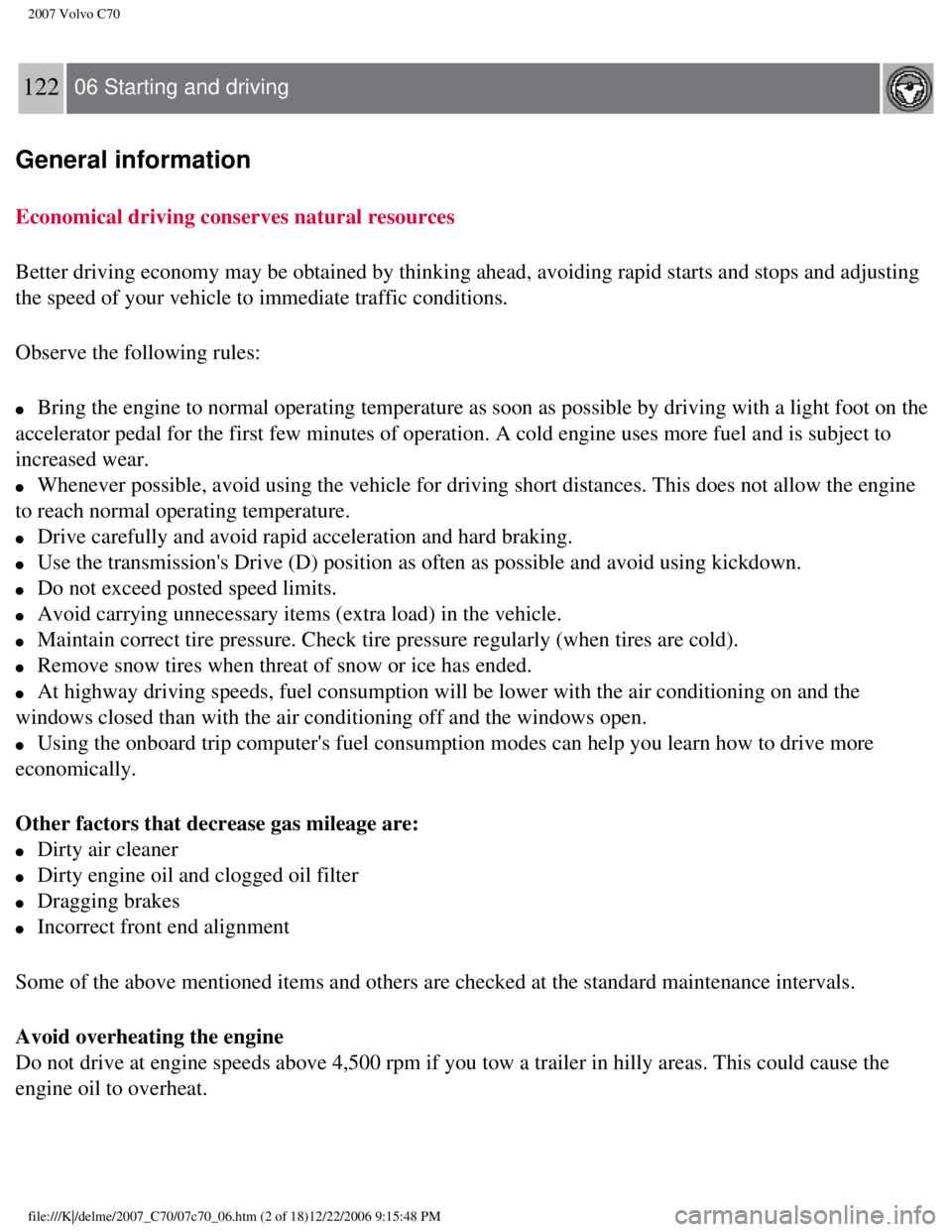
2007 Volvo C70
122 06 Starting and driving
General information
Economical driving conserves natural resources
Better driving economy may be obtained by thinking ahead, avoiding rapid\
starts and stops and adjusting
the speed of your vehicle to immediate traffic conditions.
Observe the following rules:
l Bring the engine to normal operating temperature as soon as possible by \
driving with a light foot on the
accelerator pedal for the first few minutes of operation. A cold engine \
uses more fuel and is subject to
increased wear.
l Whenever possible, avoid using the vehicle for driving short distances. \
This does not allow the engine
to reach normal operating temperature.
l Drive carefully and avoid rapid acceleration and hard braking.
l Use the transmission's Drive (D) position as often as possible and avo\
id using kickdown.
l Do not exceed posted speed limits.
l Avoid carrying unnecessary items (extra load) in the vehicle.
l Maintain correct tire pressure. Check tire pressure regularly (when tir\
es are cold).
l Remove snow tires when threat of snow or ice has ended.
l At highway driving speeds, fuel consumption will be lower with the air c\
onditioning on and the
windows closed than with the air conditioning off and the windows open. \
l Using the onboard trip computer's fuel consumption modes can help you le\
arn how to drive more
economically.
Other factors that decrease gas mileage are:
l Dirty air cleaner
l Dirty engine oil and clogged oil filter
l Dragging brakes
l Incorrect front end alignment
Some of the above mentioned items and others are checked at the standard\
maintenance intervals.
Avoid overheating the engine
Do not drive at engine speeds above 4,500 rpm if you tow a trailer in hi\
lly areas. This could cause the
engine oil to overheat.
file:///K|/delme/2007_C70/07c70_06.htm (2 of 18)12/22/2006 9:15:48 PM
Page 144 of 276
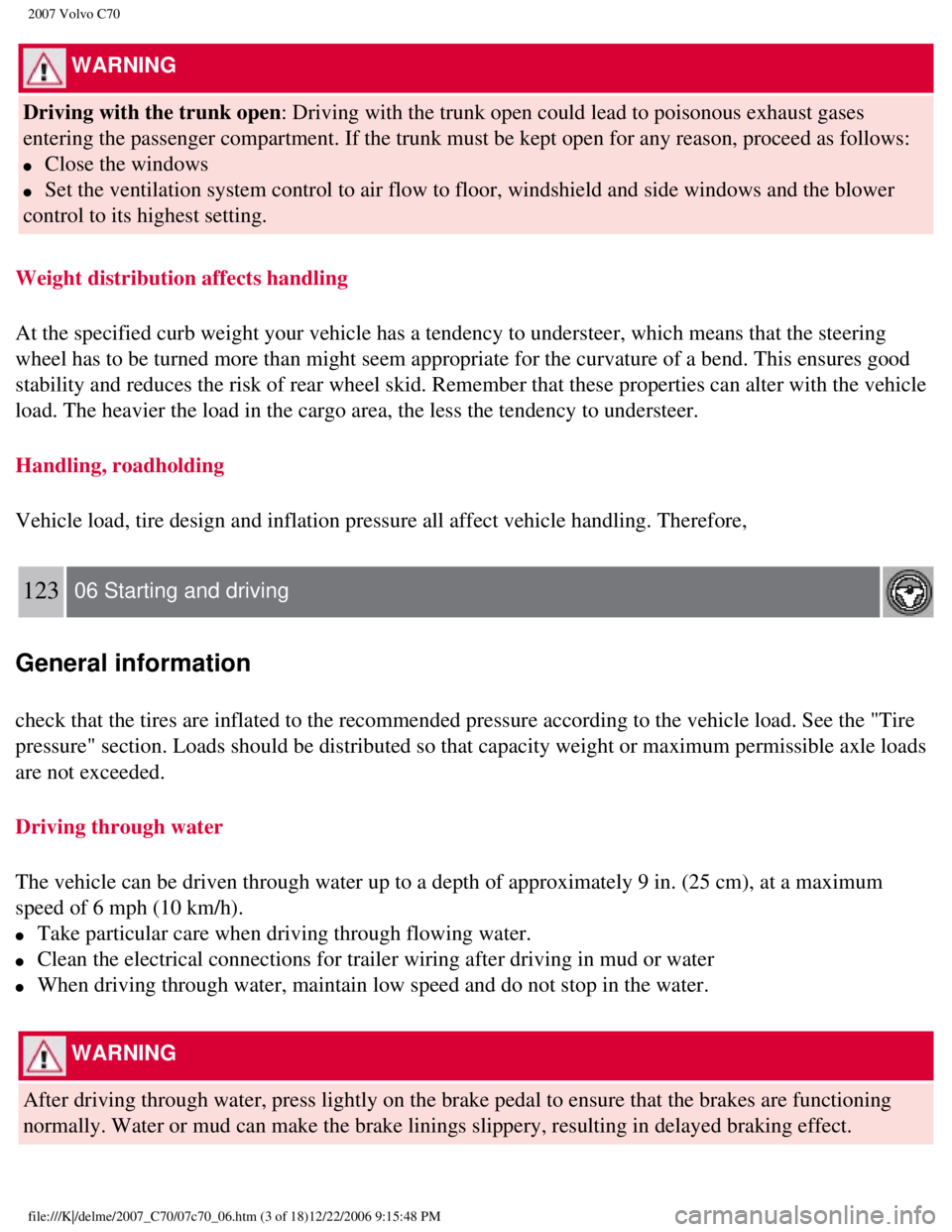
2007 Volvo C70
WARNING
Driving with the trunk open: Driving with the trunk open could lead to poisonous exhaust gases
entering the passenger compartment. If the trunk must be kept open for a\
ny reason, proceed as follows:
l Close the windows
l Set the ventilation system control to air flow to floor, windshield and \
side windows and the blower
control to its highest setting.
Weight distribution affects handling
At the specified curb weight your vehicle has a tendency to understeer, \
which means that the steering
wheel has to be turned more than might seem appropriate for the curvatur\
e of a bend. This ensures good
stability and reduces the risk of rear wheel skid. Remember that these p\
roperties can alter with the vehicle
load. The heavier the load in the cargo area, the less the tendency to u\
ndersteer.
Handling, roadholding
Vehicle load, tire design and inflation pressure all affect vehicle hand\
ling. Therefore,
123 06 Starting and driving
General information
check that the tires are inflated to the recommended pressure according \
to the vehicle load. See the "Tire
pressure" section. Loads should be distributed so that capacity weight o\
r maximum permissible axle loads
are not exceeded.
Driving through water
The vehicle can be driven through water up to a depth of approximately 9\
in. (25 cm), at a maximum
speed of 6 mph (10 km/h).
l Take particular care when driving through flowing water.
l Clean the electrical connections for trailer wiring after driving in mud\
or water
l When driving through water, maintain low speed and do not stop in the wa\
ter.
WARNING
After driving through water, press lightly on the brake pedal to ensure \
that the brakes are functioning
normally. Water or mud can make the brake linings slippery, resulting in\
delayed braking effect.
file:///K|/delme/2007_C70/07c70_06.htm (3 of 18)12/22/2006 9:15:48 PM
Page 145 of 276
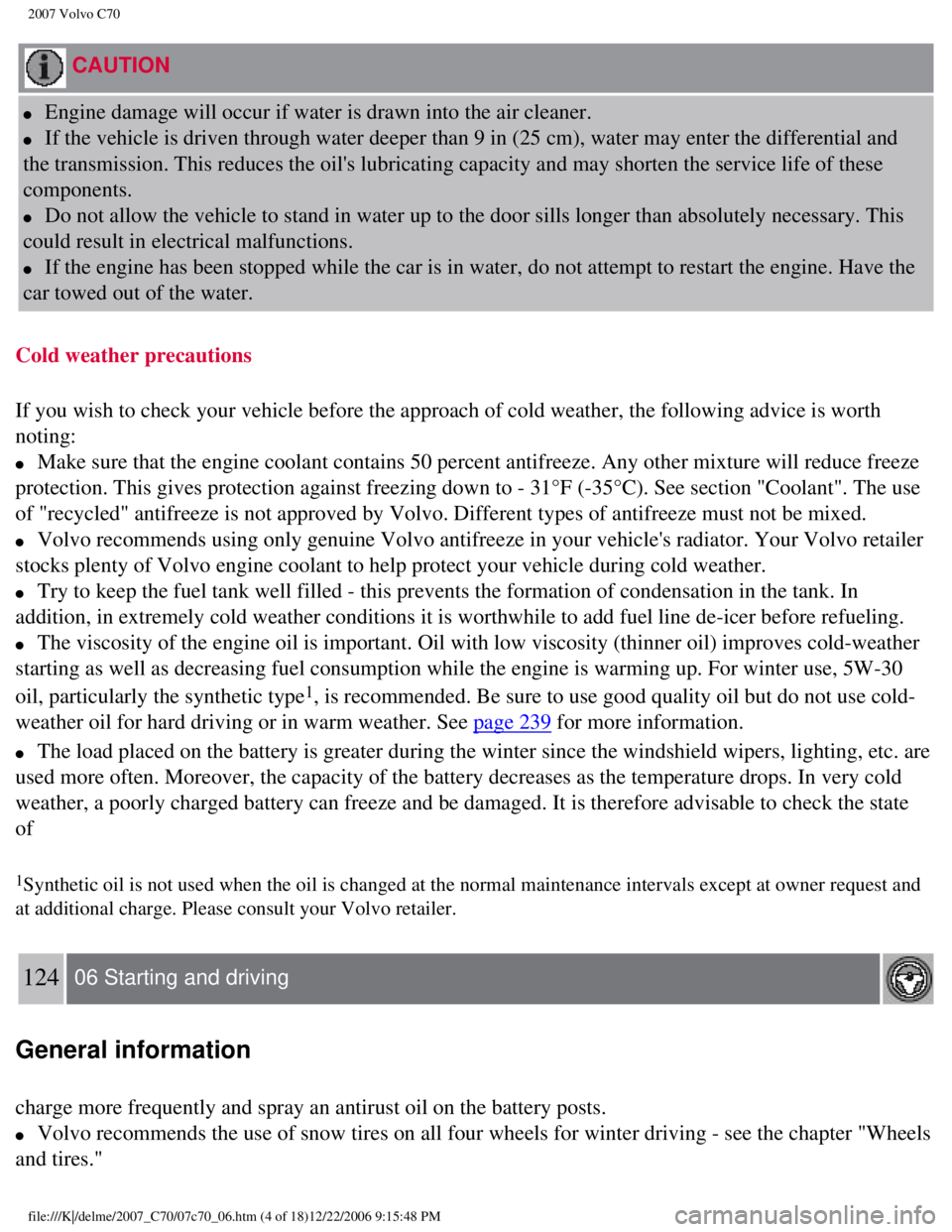
2007 Volvo C70
CAUTION
l Engine damage will occur if water is drawn into the air cleaner.
l If the vehicle is driven through water deeper than 9 in (25 cm), water\
may enter the differential and
the transmission. This reduces the oil's lubricating capacity and may sh\
orten the service life of these
components.
l Do not allow the vehicle to stand in water up to the door sills longer t\
han absolutely necessary. This
could result in electrical malfunctions.
l If the engine has been stopped while the car is in water, do not attempt\
to restart the engine. Have the
car towed out of the water.
Cold weather precautions
If you wish to check your vehicle before the approach of cold weather, t\
he following advice is worth
noting:
l Make sure that the engine coolant contains 50 percent antifreeze. Any ot\
her mixture will reduce freeze
protection. This gives protection against freezing down to - 31°F (-\
35°C). See section "Coolant". The use
of "recycled" antifreeze is not approved by Volvo. Different types of an\
tifreeze must not be mixed.
l Volvo recommends using only genuine Volvo antifreeze in your vehicle's r\
adiator. Your Volvo retailer
stocks plenty of Volvo engine coolant to help protect your vehicle durin\
g cold weather.
l Try to keep the fuel tank well filled - this prevents the formation of c\
ondensation in the tank. In
addition, in extremely cold weather conditions it is worthwhile to add f\
uel line de-icer before refueling.
l The viscosity of the engine oil is important. Oil with low viscosity (t\
hinner oil) improves cold-weather
starting as well as decreasing fuel consumption while the engine is warm\
ing up. For winter use, 5W-30
oil, particularly the synthetic type
1, is recommended. Be sure to use good quality oil but do not use cold-
weather oil for hard driving or in warm weather. See
page 239 for more information.
l The load placed on the battery is greater during the winter since the wi\
ndshield wipers, lighting, etc. are
used more often. Moreover, the capacity of the battery decreases as the \
temperature drops. In very cold
weather, a poorly charged battery can freeze and be damaged. It is there\
fore advisable to check the state
of
1Synthetic oil is not used when the oil is changed at the normal maintena\
nce intervals except at owner request and
at additional charge. Please consult your Volvo retailer.
124 06 Starting and driving
General information
charge more frequently and spray an antirust oil on the battery posts.
l Volvo recommends the use of snow tires on all four wheels for winter dri\
ving - see the chapter "Wheels
and tires."
file:///K|/delme/2007_C70/07c70_06.htm (4 of 18)12/22/2006 9:15:48 PM
Page 146 of 276

2007 Volvo C70
l To prevent the washer fluid reservoir from freezing, add washer solvents\
containing antifreeze (see
page 193 for the location of the washer fluid reservoir). This is important sin\
ce dirt is often splashed on
the windshield during winter driving, requiring the frequent use of the \
washers and wipers. Volvo Washer
Solvent should be diluted as follows: Down to 14° F (-10° C): 1 \
part washer solvent and 4 parts water
Down to 5° F (-15° C): 1 part washer solvent and 3 parts water D\
own to 0° F (- 18° C): 1 part washer
solvent and 2 parts water Down to -18° F (-28° C): 1 part washer\
solvent and 1 part water.
l Use Volvo Teflon Lock Spray in the locks.
NOTE
Avoid using de-icing sprays as they can cause damage to the
locks.
Conserving electrical current
Keep the following in mind to help minimize battery drain:
l When the engine is not running, avoid turning the ignition key to positi\
on II. Many electrical systems
(the audio system, the optional navigation system, power windows, etc)\
will function with the ignition
key in position I. This position reduces drain on the battery.
l Please keep in mind that using systems, accessories, etc that consume a \
great deal of current when the
engine is not running could result in the battery being completely drain\
ed.
l The optional 12 volt socket in the cargo area provides electrical curren\
t even with the ignition switched
off, which drains the battery.
NOTE
l If the ignition is switched on, a warning message will be displayed in t\
he text window in the
instrument panel when the battery charge is low.
l An energy conserving function designed into the vehicle's electrical sys\
tem will switch off certain
functions or reduce the load on the battery by, e.g., reducing the audio\
system's volume.
Before a long distance trip
It is always worthwhile to have your vehicle checked at a Volvo retailer\
before driving long distances.
Your retailer will also be able to supply you with bulbs, fuses, spark p\
lugs and wiper blades for your use
in the event that problems occur.
As a minimum, the following items should be checked before any long trip\
:
l Check that engine runs smoothly and that fuel consumption is normal.
l Check for fuel, oil, and fluid leakage
l Have the transmission oil level checked1.
file:///K|/delme/2007_C70/07c70_06.htm (5 of 18)12/22/2006 9:15:48 PM
Page 147 of 276
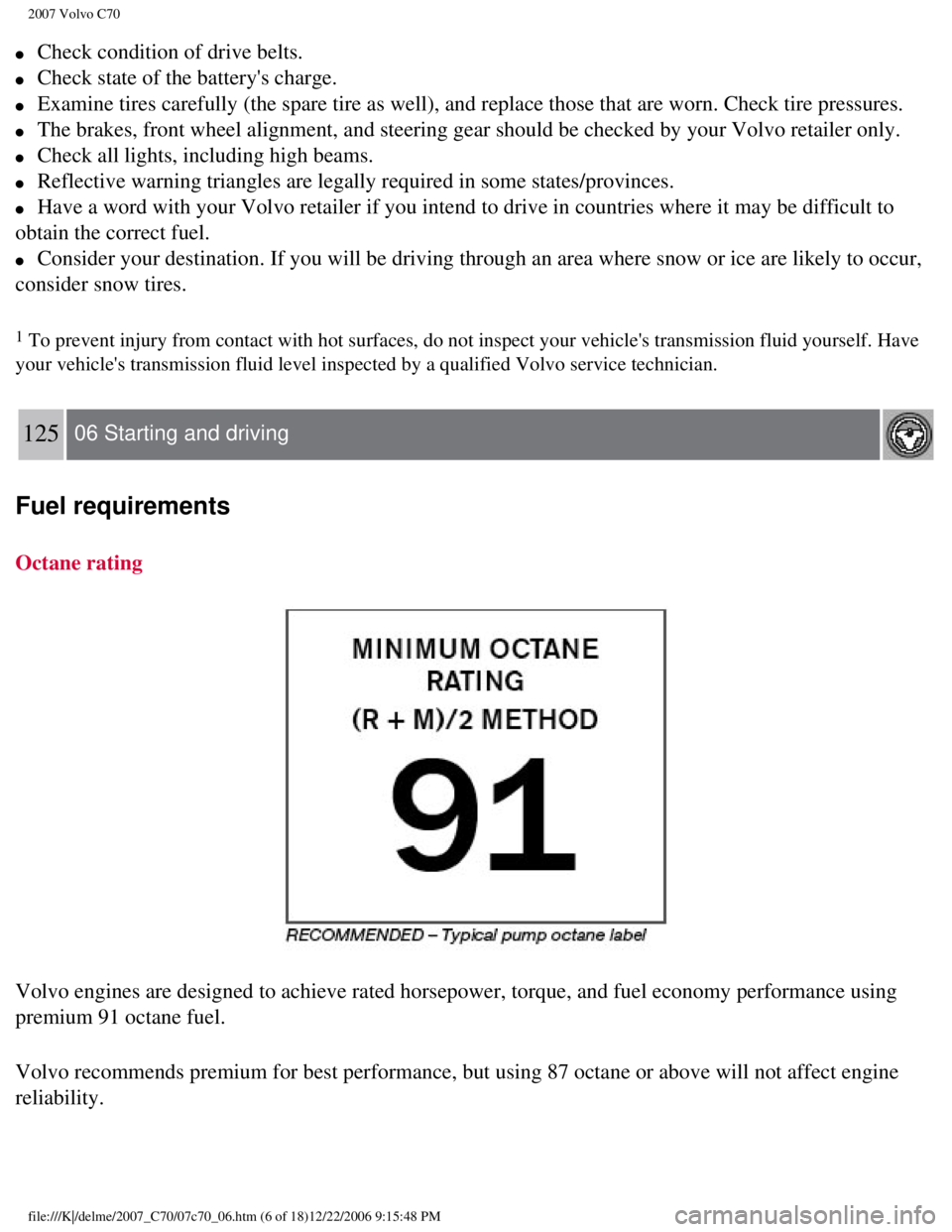
2007 Volvo C70
l Check condition of drive belts.
l Check state of the battery's charge.
l Examine tires carefully (the spare tire as well), and replace those th\
at are worn. Check tire pressures.
l The brakes, front wheel alignment, and steering gear should be checked b\
y your Volvo retailer only.
l Check all lights, including high beams.
l Reflective warning triangles are legally required in some states/provinc\
es.
l Have a word with your Volvo retailer if you intend to drive in countries\
where it may be difficult to
obtain the correct fuel.
l Consider your destination. If you will be driving through an area where \
snow or ice are likely to occur,
consider snow tires.
1 To prevent injury from contact with hot surfaces, do not inspect your v\
ehicle's transmission fluid yourself. Have
your vehicle's transmission fluid level inspected by a qualified Volvo s\
ervice technician.
125 06 Starting and driving
Fuel requirements
Octane rating
Volvo engines are designed to achieve rated horsepower, torque, and fuel\
economy performance using
premium 91 octane fuel.
Volvo recommends premium for best performance, but using 87 octane or ab\
ove will not affect engine
reliability.
file:///K|/delme/2007_C70/07c70_06.htm (6 of 18)12/22/2006 9:15:48 PM
Page 148 of 276
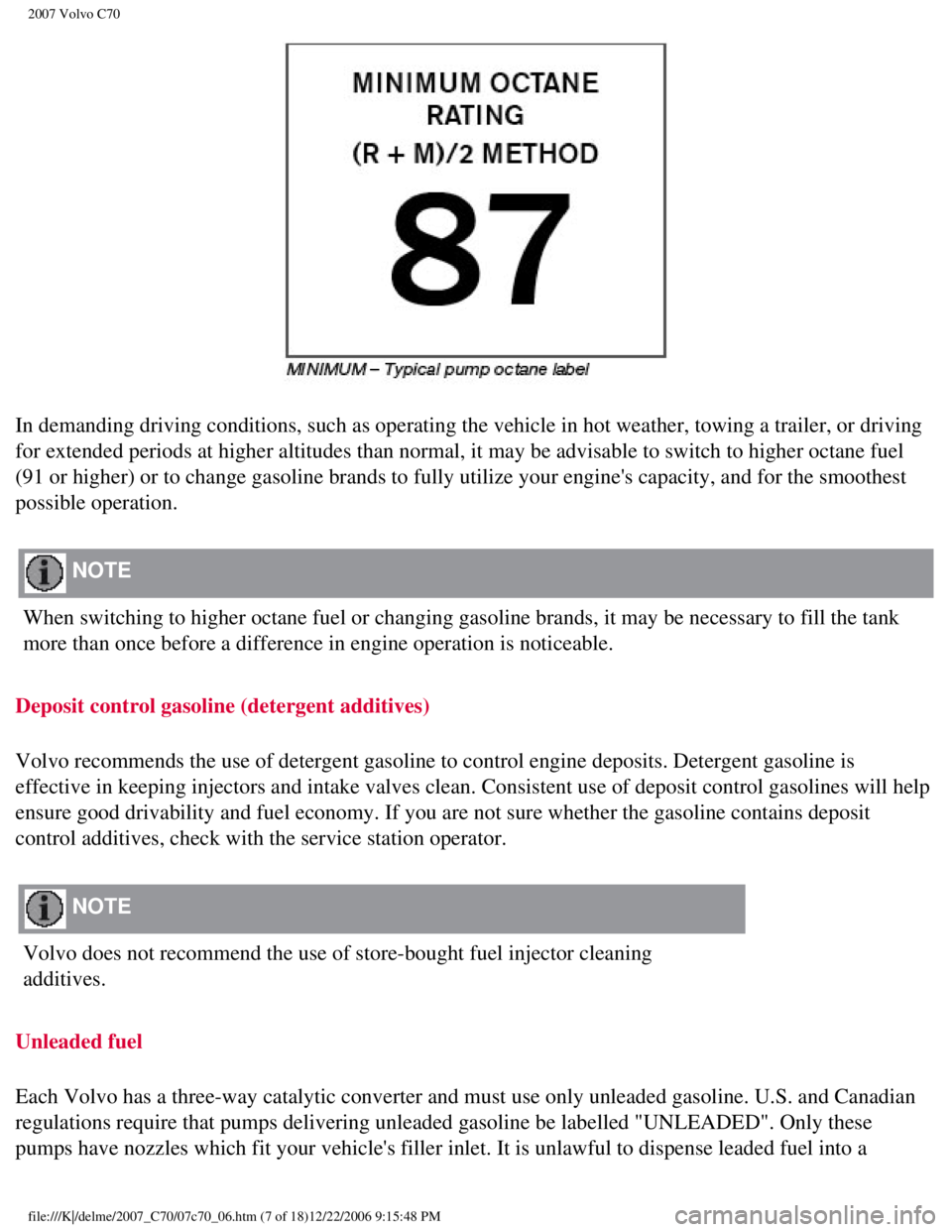
2007 Volvo C70
In demanding driving conditions, such as operating the vehicle in hot we\
ather, towing a trailer, or driving
for extended periods at higher altitudes than normal, it may be advisabl\
e to switch to higher octane fuel
(91 or higher) or to change gasoline brands to fully utilize your engi\
ne's capacity, and for the smoothest
possible operation.
NOTE
When switching to higher octane fuel or changing gasoline brands, it may\
be necessary to fill the tank
more than once before a difference in engine operation is noticeable.
Deposit control gasoline (detergent additives)
Volvo recommends the use of detergent gasoline to control engine deposit\
s. Detergent gasoline is
effective in keeping injectors and intake valves clean. Consistent use o\
f deposit control gasolines will help
ensure good drivability and fuel economy. If you are not sure whether th\
e gasoline contains deposit
control additives, check with the service station operator.
NOTE
Volvo does not recommend the use of store-bought fuel injector cleaning \
additives.
Unleaded fuel
Each Volvo has a three-way catalytic converter and must use only unleade\
d gasoline. U.S. and Canadian
regulations require that pumps delivering unleaded gasoline be labelled \
"UNLEADED". Only these
pumps have nozzles which fit your vehicle's filler inlet. It is unlawful\
to dispense leaded fuel into a
file:///K|/delme/2007_C70/07c70_06.htm (7 of 18)12/22/2006 9:15:48 PM
Page 149 of 276
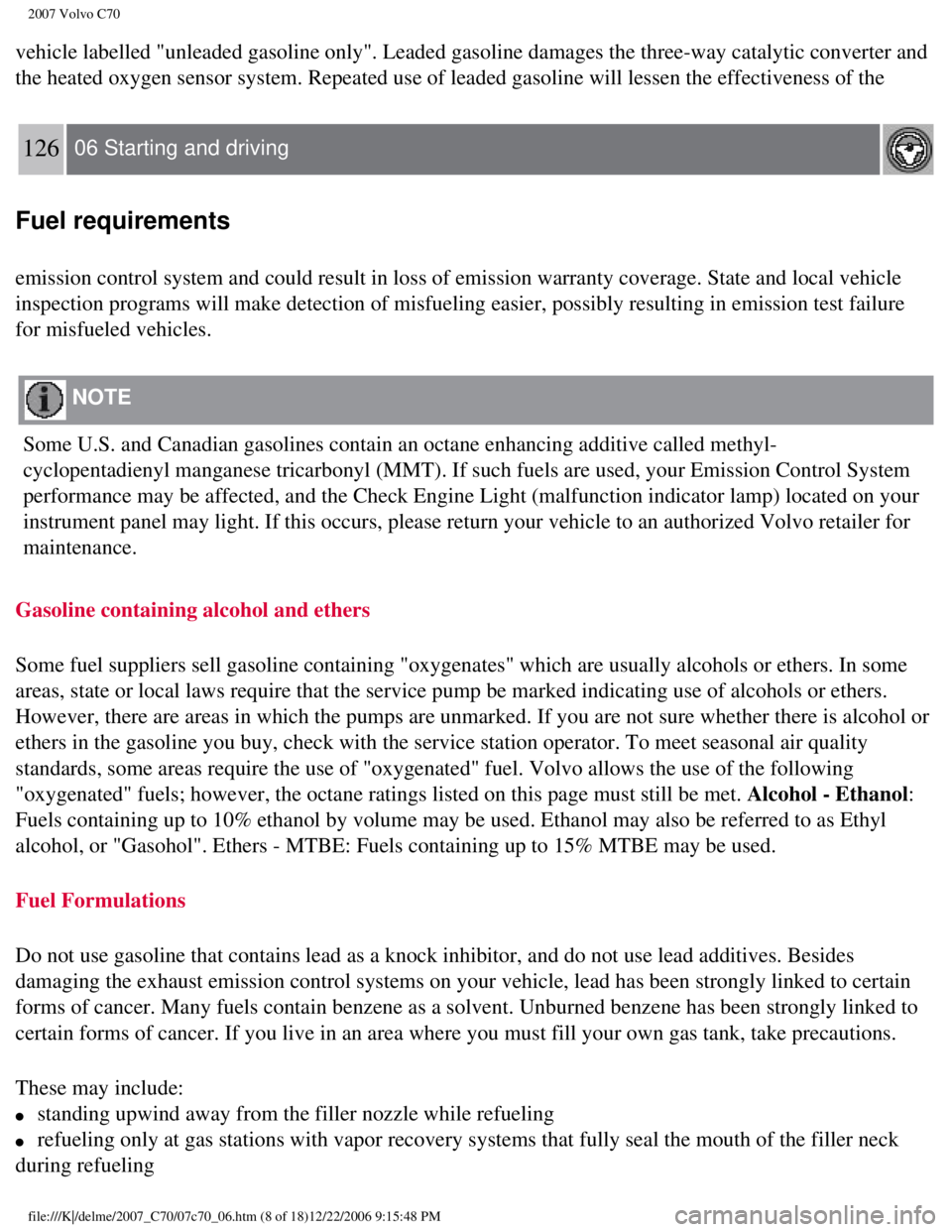
2007 Volvo C70
vehicle labelled "unleaded gasoline only". Leaded gasoline damages the t\
hree-way catalytic converter and
the heated oxygen sensor system. Repeated use of leaded gasoline will le\
ssen the effectiveness of the
126 06 Starting and driving
Fuel requirements
emission control system and could result in loss of emission warranty co\
verage. State and local vehicle
inspection programs will make detection of misfueling easier, possibly r\
esulting in emission test failure
for misfueled vehicles.
NOTE
Some U.S. and Canadian gasolines contain an octane enhancing additive ca\
lled methyl-
cyclopentadienyl manganese tricarbonyl (MMT). If such fuels are used, \
your Emission Control System
performance may be affected, and the Check Engine Light (malfunction in\
dicator lamp) located on your
instrument panel may light. If this occurs, please return your vehicle t\
o an authorized Volvo retailer for
maintenance.
Gasoline containing alcohol and ethers
Some fuel suppliers sell gasoline containing "oxygenates" which are usua\
lly alcohols or ethers. In some
areas, state or local laws require that the service pump be marked indic\
ating use of alcohols or ethers.
However, there are areas in which the pumps are unmarked. If you are not\
sure whether there is alcohol or
ethers in the gasoline you buy, check with the service station operator.\
To meet seasonal air quality
standards, some areas require the use of "oxygenated" fuel. Volvo allows\
the use of the following
"oxygenated" fuels; however, the octane ratings listed on this page must\
still be met. Alcohol - Ethanol:
Fuels containing up to 10% ethanol by volume may be used. Ethanol may al\
so be referred to as Ethyl
alcohol, or "Gasohol". Ethers - MTBE: Fuels containing up to 15% MTBE ma\
y be used.
Fuel Formulations
Do not use gasoline that contains lead as a knock inhibitor, and do not \
use lead additives. Besides
damaging the exhaust emission control systems on your vehicle, lead has \
been strongly linked to certain
forms of cancer. Many fuels contain benzene as a solvent. Unburned benze\
ne has been strongly linked to
certain forms of cancer. If you live in an area where you must fill your\
own gas tank, take precautions.
These may include:
l standing upwind away from the filler nozzle while refueling
l refueling only at gas stations with vapor recovery systems that fully se\
al the mouth of the filler neck
during refueling
file:///K|/delme/2007_C70/07c70_06.htm (8 of 18)12/22/2006 9:15:48 PM
Page 150 of 276
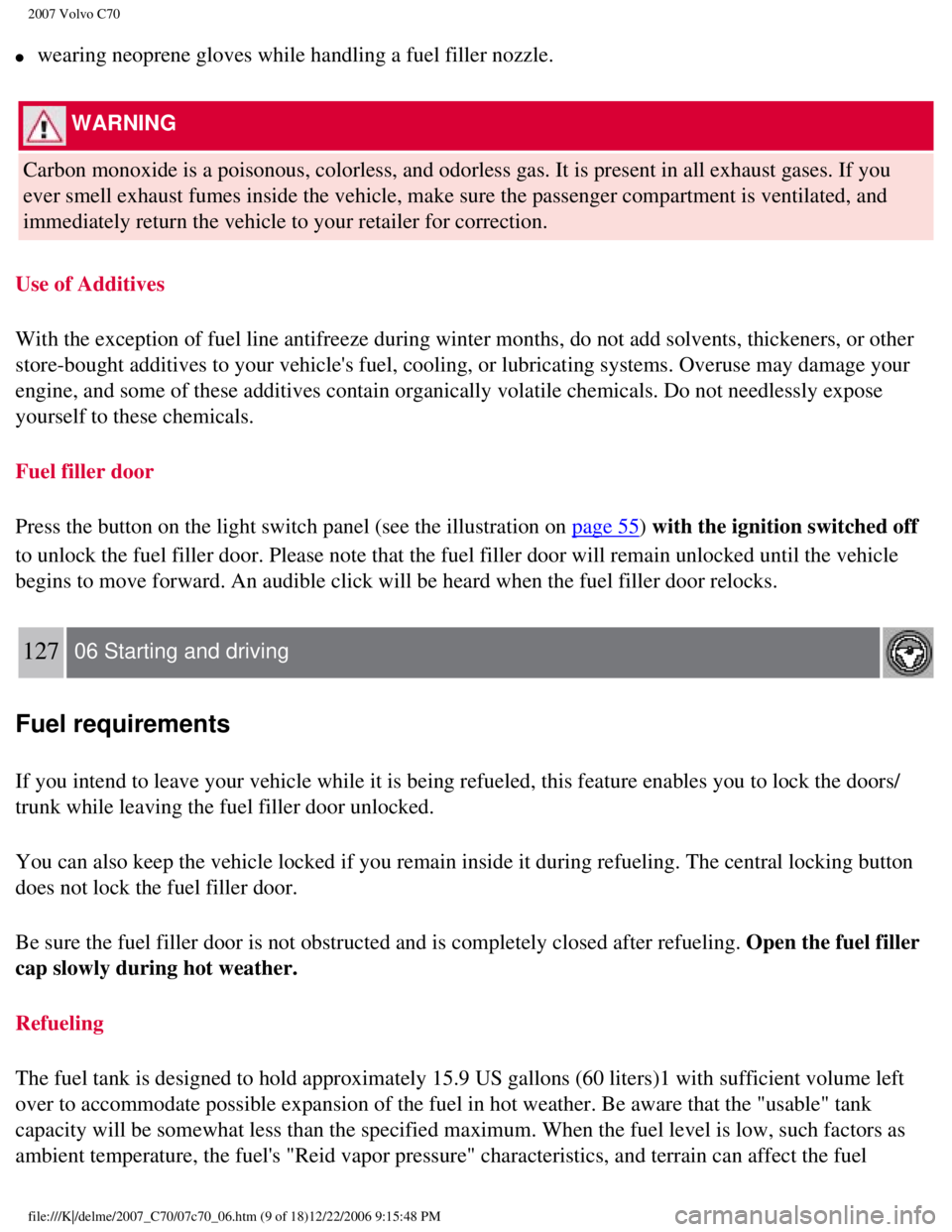
2007 Volvo C70
l wearing neoprene gloves while handling a fuel filler nozzle.
WARNING
Carbon monoxide is a poisonous, colorless, and odorless gas. It is prese\
nt in all exhaust gases. If you
ever smell exhaust fumes inside the vehicle, make sure the passenger com\
partment is ventilated, and
immediately return the vehicle to your retailer for correction.
Use of Additives
With the exception of fuel line antifreeze during winter months, do not \
add solvents, thickeners, or other
store-bought additives to your vehicle's fuel, cooling, or lubricating s\
ystems. Overuse may damage your
engine, and some of these additives contain organically volatile chemica\
ls. Do not needlessly expose
yourself to these chemicals.
Fuel filler door
Press the button on the light switch panel (see the illustration on
page 55) with the ignition switched off
to unlock the fuel filler door. Please note that the fuel filler door wi\
ll remain unlocked until the vehicle
begins to move forward. An audible click will be heard when the fuel fil\
ler door relocks.
127 06 Starting and driving
Fuel requirements
If you intend to leave your vehicle while it is being refueled, this fea\
ture enables you to lock the doors/
trunk while leaving the fuel filler door unlocked.
You can also keep the vehicle locked if you remain inside it during refu\
eling. The central locking button
does not lock the fuel filler door.
Be sure the fuel filler door is not obstructed and is completely closed \
after refueling. Open the fuel filler
cap slowly during hot weather.
Refueling
The fuel tank is designed to hold approximately 15.9 US gallons (60 lit\
ers)1 with sufficient volume left
over to accommodate possible expansion of the fuel in hot weather. Be aw\
are that the "usable" tank
capacity will be somewhat less than the specified maximum. When the fuel\
level is low, such factors as
ambient temperature, the fuel's "Reid vapor pressure" characteristics, a\
nd terrain can affect the fuel
file:///K|/delme/2007_C70/07c70_06.htm (9 of 18)12/22/2006 9:15:48 PM